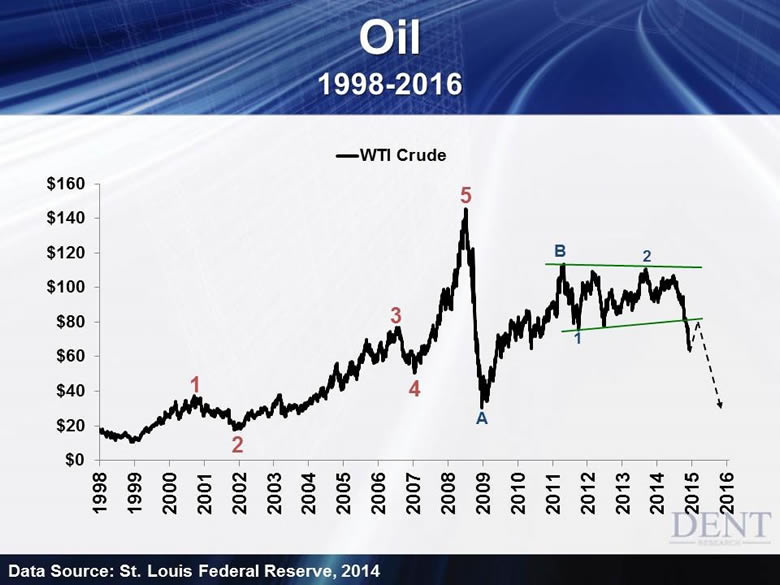Gold, Oil, Copper... Commodities Breakdown
Commodities / Commodities Trading Dec 09, 2014 - 02:54 PM GMTBy: Harry_Dent
 I have been commenting on how the CRB commodity index – including oil, gold and copper – have been trading in a sideways pattern for the past three years and that at some point they would break down.
I have been commenting on how the CRB commodity index – including oil, gold and copper – have been trading in a sideways pattern for the past three years and that at some point they would break down.
The break down just happened. Oil broke below support at $75 to $80, copper broke below $2.90 to $3, gold broke below $1,180 and the CRB broke below $270.
But just when you would normally think they would break down sharply out of such long trading ranges, these commodities are now holding and look like they may have bottomed for now. Gold got extremely oversold, the most in years, and now looks likely to rally back towards $1,300 to $1,380 in the months ahead.
This is what these now trader-dominated bubble markets are doing. Traders take things up higher than anyone would think and then take them below support to scare every one out, then they buy and drive prices up again.
They’re intent on screwing everyone. The central banks are enabling them with zero interest rates which in turn allows them to leverage at unprecedented rates and producing a much high impact on the markets.
This makes these the trickiest markets I’ve ever seen to call short-term.
Oil’s Landscape
Oil’s plunge has been the most dramatic, as it was back in the crash of 2008 — $147 to $32 in just over four months. I’ve never seen a market fall that much… that fast.
It was caused by the high leverage of such increasingly dominant traders and hedge funds. And it was steep because they had to sell due to massive margin calls.
Oil has traded between $114 and $75 and finally broke down more sharply than other commodities, hitting $64 on December 1. It’s traded between $63 and $68 since then.
Oil is extremely oversold right now and has minor support from the early 2010 low around $64. After that there’s no obvious support on this chart. The next support is at $32, the late 2008 low… definitely not a pretty picture.
Saudi Arabia thinks oil will settle down around $60. Maybe near term, but that’s not what this chart is suggesting just down the road.

The most likely scenario would be a rally back to $75 to $80, then another crash sometime in 2015 down to as low as $32. I see oil ultimately bottoming around $10 to $20 in the years ahead.
But that could only happen if global growth slows much more and especially in emerging countries. A new China momentum indicator suggests China will slow to 4% to 5% over the next year, lower than its 6% low in 2009.
This can’t be good for the global economy and would strongly suggest another crash in stock prices as well.
Our view is that falling oil and commodity prices are a sign of the slowdown and deflation crisis ahead — not a good sign this time around.
In a deflationary environment, falling commodity and oil prices is not a good thing even though there are obvious benefits to consumers in the U.S., developed countries and China. Likewise, rising oil and commodity prices aren’t good in an inflationary environment (think about the one in the 1970s) even though such prices do benefit emerging countries and commodity exporters.
And what does this do to the fracking industry in the U.S.?
That outcome won’t be good at all, especially as some producers will go under at current prices and many more below $58 a barrel. Energy companies are responsible for 20% of the junk bond debt in the U.S.
That’s the whole purpose of Saudi Arabia not cutting production with the increasing excess oil capacity. It wants to kill off its fracking and less-efficient oil-producing rivals.
If oil does rally in the coming weeks or months and then turns around and starts to collapse again and breaks back below $63 — it’ll be downhill from there.
We should be watching out for a potential global stock crash.
Harry
Follow me on Twitter @HarryDentjr
Harry studied economics in college in the ’70s, but found it vague and inconclusive. He became so disillusioned by the state of the profession that he turned his back on it. Instead, he threw himself into the burgeoning New Science of Finance, which married economic research and market research and encompassed identifying and studying demographic trends, business cycles, consumers’ purchasing power and many, many other trends that empowered him to forecast economic and market changes.
Copyright © 2014 Harry Dent- All Rights Reserved Disclaimer: The above is a matter of opinion provided for general information purposes only and is not intended as investment advice. Information and analysis above are derived from sources and utilising methods believed to be reliable, but we cannot accept responsibility for any losses you may incur as a result of this analysis. Individuals should consult with their personal financial advisors.
© 2005-2022 http://www.MarketOracle.co.uk - The Market Oracle is a FREE Daily Financial Markets Analysis & Forecasting online publication.



